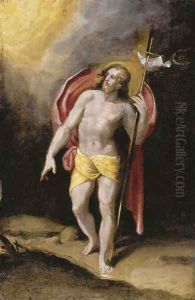Orazio Samachini Paintings
Orazio Samacchini, born in 1532 in Bologna, Italy, was a prominent figure in the Italian Renaissance painting movement. His work is often associated with the Mannerist style, which emerged in the late Renaissance period, emphasizing artificiality and the use of unorthodox and complex compositions. Samacchini's artistic journey was deeply influenced by the cultural and intellectual environment of Bologna, a city renowned for its vibrant artistic community during the 16th century. He was an integral part of the Bolognese School, a group of artists who played a crucial role in the development of late Renaissance art in Italy.
Samacchini received his initial training in the workshop of Pellegrino Tibaldi, another distinguished artist of the time, and was significantly influenced by the works of Parmigianino, a leading figure in the Mannerist movement. Throughout his career, Orazio Samacchini developed a style characterized by graceful figures, sophisticated use of color, and intricate compositions that often depicted religious and mythological themes. His work not only reflects the aesthetic ideals of Mannerism but also demonstrates a deep understanding of human emotion and spirituality.
One of the highlights of Samacchini's career was his work at the Oratory of San Colombano in Bologna, where his frescoes are considered some of his finest achievements. These works showcase his skill in creating dynamic compositions that combine dramatic narrative with delicate beauty. Samacchini also contributed significantly to the decoration of various churches and public buildings in Bologna and other Italian cities, leaving behind a legacy that continues to be admired for its elegance and complexity.
Orazio Samacchini's influence extended beyond his immediate contemporaries. His paintings were celebrated for their innovative approach to composition and their ability to convey complex emotions through art. Despite his relatively short life, passing away in 1577 at the age of 45, Samacchini's contributions to the Italian Renaissance and the Mannerist movement have secured his place as a significant figure in the history of art. His works remain a testament to the creative vibrancy of the 16th-century Italian art scene and continue to draw interest from art historians and enthusiasts around the world.
